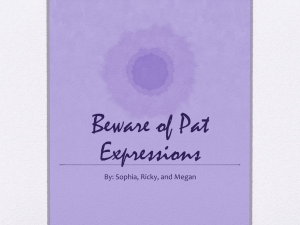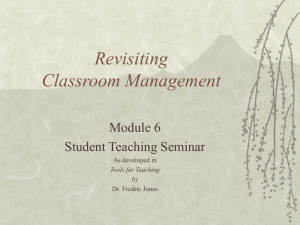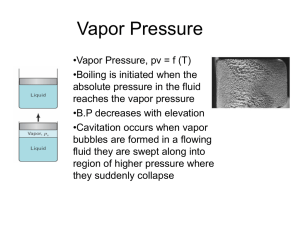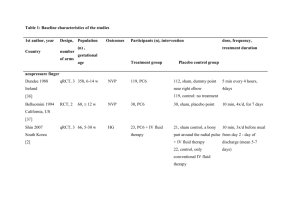Physics 102 Part II Thermal Physics
advertisement
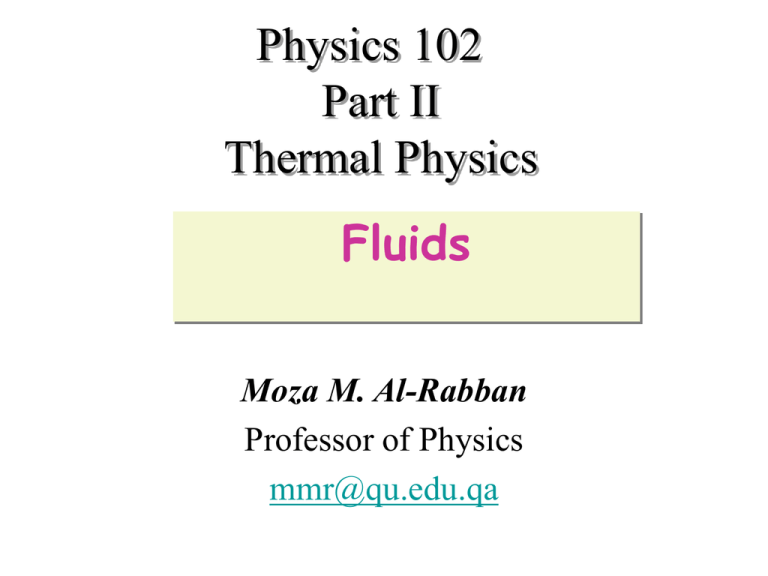
Physics 102 Part II Thermal Physics Fluids Moza M. Al-Rabban Professor of Physics mmr@qu.edu.qa Text Book • Physics, by James S. Walker • Chapters 15, 16, and 17 Outline 15-1 Density 15-2 Pressure 15-3 Static Equilibrium in Fluids: Pressure and Depth 15-4 Archimedes' Principle and Buoyancy 15-5 Applications of Archimedes' Principle 15-6 Fluid Flow and Continuity 15-7 Bernoulli's Equation 15-8 Applications of Bernoulli's Equation *15-9 Viscosity and Surface Tension States Of Matter • Solids • Liquids • gases Solids: Solids tends to hold their shapes. Although the atoms vibrate around fixed equilibrium positions, they do not have enough energy to break the bound with their neighbors. Fluids Liquids and Gases • Liquids and Gases, do not hold their shapes. • A liquid flows and takes the shape of its container and a gas expands to fill its container. • The atoms or molecules in Fluid do not have fixed positions, so a fluid does not have a definite shape. Density • Definition of Density, M /V SI unit : kg / m 3 The denser a material, the more mass it has in any given volume. Pressure • Definition of Pressure, P P F /A SI units: N / m 2 Example 1: Find the pressure exerted on the skin of a balloon if you press with a force of 2.1 N using (a) your finger or (b) a needle. Assume the area of your fingertip is 1.0 104 m 2 , and the area of the needle tip is 2.5 107 m2 (c) Find the minimum force necessary to pop the balloon with the needle, given that the balloon pops with a pressure of 3.0 105 N / m2 Solve (a) Calculate the pressure exerted by the finger: P F 2.1 N 4 2 2 . 1 10 N / m A 1.0 10 4 m 2 (b) Calculate the pressure exerted by the needle: P F 2.1 N 6 2 8 . 4 10 N / m A 2.5 10 7 m 2 (c) F PA 3.0 105 N / m2 2.5 107 m2 0.075N Atmospheric Pressure and Gauge Pressure • Atmospheric Pressure, Pat Pat 1.01 105 N / m 2 SI unit : N / m 2 1Pa ( pascal) 1N / m 2 Pat 101kPa 1bar 105 Pa 1Pat Gauge pressure, Pg • The pressure in a fluid acts equally in all directions, and acts at right angles to any surface. • In many cases we are interested in difference between a given pressure and atmospheric pressure. Pg P Pat Gauge Pressure Does the flat tire on your automobile have zero air pressure? If it is completely flat, it still has the atmospheric pressure air in it. To be sure, it has zero useful pressure in it, and your tire gauge would read zero Newton per square meter. Most gauges read the excess of pressure over atmospheric pressure and this excess is called "gauge pressure". Pgauge Pabsulute Pat When a system is at atmospheric pressure like the left image above, the gauge pressure is said to be zero. In this image, the system has been opened so that it is at equilibrium with the atmosphere. In the right image, the system has been closed and the plunger pushed down until the pressure reads about 15 lb/in2. Static Equilibrium in Fluids: Pressure and Depth Ftop Pat A M V , V hA W Mg Vg hAg Fbottom Ftop W Pat A hAg Pbottom Fbottom Pat A hAg Pat gh A A P Pat gh This expression holds for any liquid with constant density and a pressure Pat at its upper surface. The relation P P at two points in a fluid. gh Dependence of Pressure on depth P2 P1 gh can be applied to any Example3: A cubical box 20.00 cm on a side is completely immersed in a fluid. At the top of the box the pressure is 105.0 kPa; at the bottom the pressure is 106.8 kPa. What is the density of the fluid? Solve: P2 P1 gh P2 P1 gh 1.068105 Pa 1.050105 Pa 3 920 kg / m 9.81m / s 2 0.2000m A Simple Barometer An interesting application of the variation of pressure with depth is the barometer, which can be used to measure atmospheric pressure. The pressure in the tube at depth h below the vacuum is 0 + gh = gh At the level of fluid in the bowel we know that the pressure is one atmosphere, therefore, Pat = gh A fluid that is often used in such a barometer is mercury (Hg), with a density of 1.3595104 kg / m3 The corresponding height for a column of mercury is Pat 1.013105 Pa h 760m m 4 3 2 g 1.359510 kg / m 9.81m / s 1 atm osphere Pat 760m m Hg Fluid Seeks Its Own Level When the levels are equal, the pressure is the same at the base of each (a) arm of the U tube. As a result, the fluid in the horizontal section of the U is in equilibrium. (b) With unequal heights, the pressure are different. In this case, the pressure is greater at the base of the right arm, hence fluid will flow toward the left and the level will equalize. Example 4: Oil and Water Don’t Mix A U-shaped tube is filled mostly with water, but a small amount of vegetable oil has been added to one side, as shown in the sketch. The density of the water is 1.00103 kg / m3 , and the density of the oil is 9.20102 kg / m3 If the depth of the oil is 5.00 cm, what is the difference in level h between the top of the oil on one side of the U and the top of the water on the other side? Solution 1. Find the pressure at point A, where the depth of the water is h1 PA Pat water gh1 2. Find the pressure at point B, where the depth of the water is h2 = 5.00 cm PB Pat oil gh2 3. Set PA equal PB: Pat water gh1 Pat oil gh2 Example 4: Oil and Water Don’t Mix A U-shaped tube is filled mostly with water, but a small amount of vegetable oil has been added to one side, as shown in the sketch. The density of the water is , and the density of the oil is If the depth of the oil is 5.00 cm, what is the difference in level h between the top of the oil on one side of the U and the top of the water on the other side? 4. Solve for the depth of the water,h1 oil h1 h2 water 9.20102 kg / m3 4.60 cm 5.00 cm 3 3 1.0010 kg / m h h2 h1 5.00 cm 4.60 cm 0.40 cm Pascal’s Principal An external pressure applied to an enclosed fluid is transmitted unchanged to every point within the fluid. P F1 / A1 F2 P A2 A2 F2 F1 / A1 A2 F1 F1 A1 A1d1 A2 d 2 A1 d 2 d1 A2 A hydraulic lift End of Lecture 13

